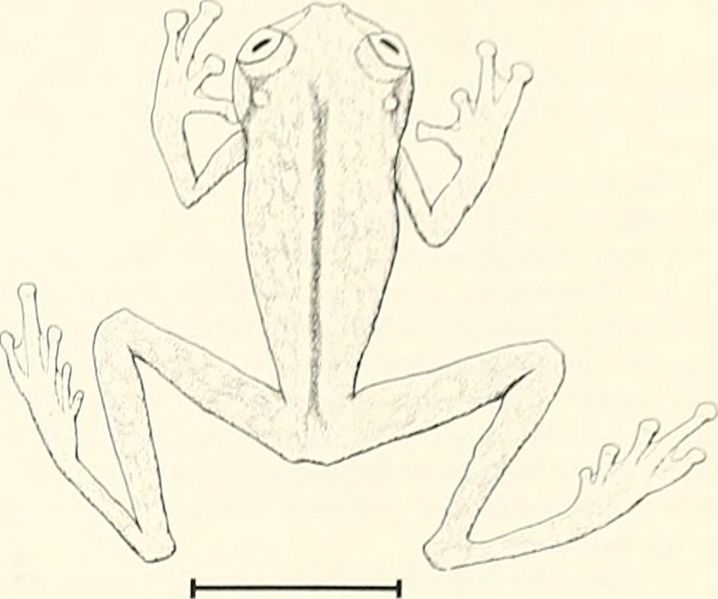Image: Bulletin (1971-) (20429549861)

Description: Title: Bulletin Identifier: bulletin7073sout (find matches) Year: 1971- (1970s) Authors: Southern California Academy of Sciences Subjects: Science; Natural history; Natural history Publisher: Los Angeles, Calif. : The Academy Contributing Library: New York Botanical Garden, LuEsther T. Mertz Library Digitizing Sponsor: The LuEsther T Mertz Library, the New York Botanical Garden View Book Page: Book Viewer About This Book: Catalog Entry View All Images: All Images From Book Click here to view book online to see this illustration in context in a browseable online version of this book. Text Appearing Before Image: 1973 SYSTEMAT1CS OF THE COSTA KHAN GLASS-FROGS 1,7 Remarks: Calling males of this species were taken ai the type locality en three occasions, .Inly 17-18 and August 5, 1963 anil June I. 1964. The frogs were found on the upper sin- faces of leaves on low herbaceous hushes helween 0.5-1 m above a shallow (5-7 cm deep) stream about 1.5 m wide. A sonograph of the call is shown (Fig. 4). The type locality is in a Premonlane Rain- forest, following the classification of Holdridge (1967). along the Pacific slope of the Cordillera Costena thai separates the narrow coastal plain from the interior valley of the Rio General. This place, near the small village of Alfombra, is also the type locality for five other nominal taxa of reptiles and amphibians: Anolis humilis mar- supialis Taylor. 1956; Dermophis occidentalis Taylor, 1955; Dipsas tenuissima Taylor, 1954; II via legleri Taylor, 1958; and Neusticurus apo- demus Uzzell 1966. Although the Anolis and Dermophis are representatives of wide-ranging species (A. humilis and D. parviceps, respec- tively) the Hyla and Dipsas are valid species restricted in range to Pacific southwestern Costa Rica and adjacent extreme southwestern Panama. The Neusticurus and Centrolenella are not known to occur elsewhere. At the type locality Centrolenella vireovittata was found sympatrically with C. valerioi of the fleischmanni group. Centrolenella fleischmanni and C. colymbiphyllum are known from a nearby locality Quebrada Salto, 6.4 km SW San Isidro de El General, near Palma on the road to Dominical. 750 m. on the interior slope of the Cordillera Costena. Centrolenella granulosa and C. prosoblepon of the prosoblepon group were also taken in virtual sympatry with C. vireo- vittata at the type locality. DISTRIBUTIONS Fleischmanni Group: The following lists include all Costa Rican locality records for the members of the fleischmanni group based upon material at the Uni- versity of Southern California and the samples now at the University of Kansas that formed the basis for Taylor's (1958) review. Centrolenella chirripoi—LIMON: Suretka on Rio Cocolis, 60 m (Fig. 6). Centrolenella colymbiphyllum—ALAJUELA: Cari- blanco; 1 km SW and Cinchona: CARTAGO: 8.8 km NE and Tapanti, Rio Quirk GUANACASTE: Finca San Bosco; PUNTARENAS: Golfito; Las duces; 0.5 km SE, ESE, SW, 1.75 km ESE, 2.6 km ESE Monteverde; 3 km W. 3 km SW Rincon de Osa: SAN Text Appearing After Image: Figure 5. Dorsal view of a male paratype (USC- CRE 6101 ) of Centrolenella vireovittata: scale equals 1 cm. JOSE: Quebrada Salto, 6.4 km S San Isidro de El General; 6-1450 m (Fig. 6). Centrolenella fleischmanni—ALAJUELA: Candc- laria de Naranjo; Rio Cariblanco and Sarapiqui road: nr. Carrizal; Cinchona: nr. La Florencia; 3.2 km E La Fortuna; San Jose. nr. Rio Jesus: Sarchi: Rio Segundo; nr. Tacares; Tesalia; S km N Zarcero: CARTAGO: Cartago: 1.5 km SW Chitaria: Floren- cia: Institute Interamericano de Ciencias Agricolas. nr. Turrialba; Moravia de Chirripo; 1 km S Orosi; 1 km E Pacayas; 1 km NE and Tapanti: 1-2 km SE Santa Teresa: GUANACASTE: 1.9. 3 km E, 2 km NW. 1.2 km SW Tilaran: HEREDIA: 1.6 km ENE La Uvita; San Jose de la Montana; LIMON: 16 km SW (Surayo), 20 km SW (Alto Lari) Amubri: Los Diamantes: Guacimo: Pandora: PUNTARENAS: 1.6 km SW Aguabuena; Rio Coton: 0.5 km ESE. 0.5 km SW Monteverde; SAN JOSE: Alto Guadelupe: Rio Claro-Rio La Hondura: Curridabat; Desamparados: 3.2 km WSW Escazu: El General: Guadelupe: Que- brada Salto. 6.4 km S and San Isidro de El General; San Jose: La Palma; Quizarra: San Pedro. Ciudad Universitaria; 50-1680 m (Fig. 7). This speciev i^ known from humid lowland and premontane forests from Mexico throughout Central America through Colombia to northwestern Ecuador and eastward through Venezuela to Surinam. It is possible that more than one species is involved in the material as- signed to fleischmanni by Goin (1964). but only field studies give hope of clarifying their status. Centrolenella talamancae—CARTAGO: Moravia de Chirripo. 1116 m (Fig. 6). Centrolenella valerioi—ALAJUELA: Cariblanco. Rio Cariblanco and Sarapiqui id.: CARTAGO: 1.5 km S Chitaria: Florencia: Moravia de Chirripo: nr. bridge over Rio Reventazon. 4.5 km SE Turrialba: LIMON: Suretka: PUNTARENAS: 6.4 km SE and Golfito: Palmar: 1 km W Platanillo: 3 km W. 2.5 Note About Images Please note that these images are extracted from scanned page images that may have been digitally enhanced for readability - coloration and appearance of these illustrations may not perfectly resemble the original work.
Title: Bulletin (1971-) (20429549861)
Credit: https://www.flickr.com/photos/internetarchivebookimages/20429549861/ Source book page: https://archive.org/stream/bulletin7073sout/#page/n406/mode/1up
Author: Internet Archive Book Images
Permission: At the time of upload, the image license was automatically confirmed using the Flickr API. For more information see Flickr API detail.
Usage Terms: No known copyright restrictions
License: No restrictions
License Link: https://www.flickr.com/commons/usage/
Attribution Required?: No
Image usage
The following page links to this image:

